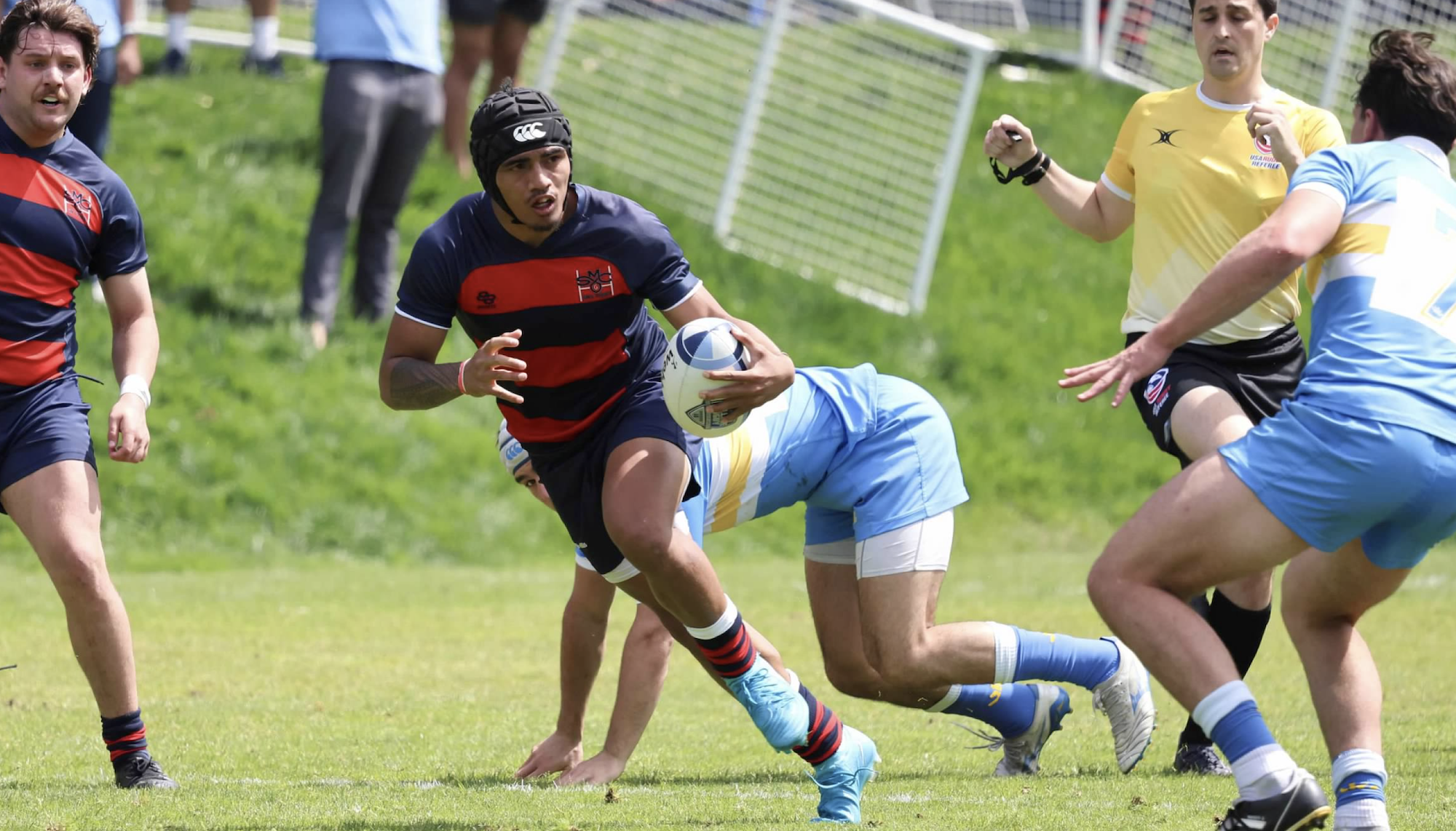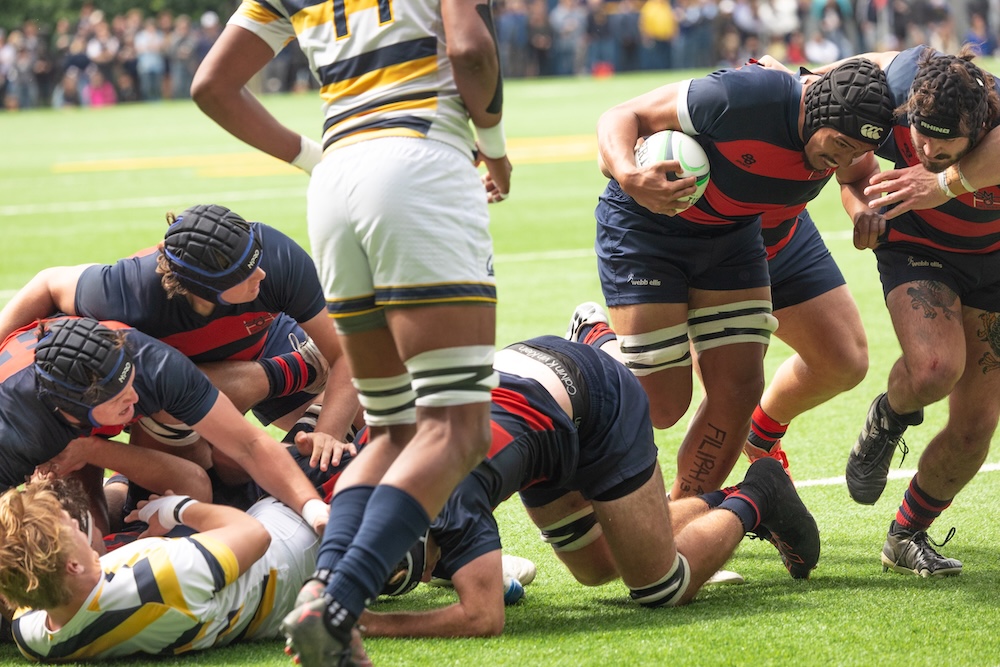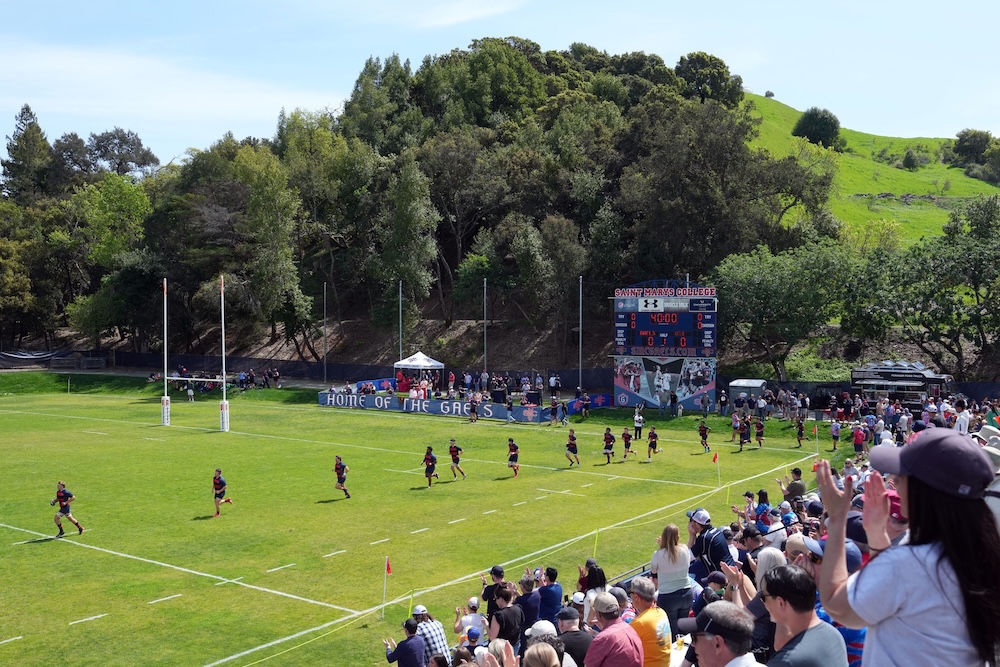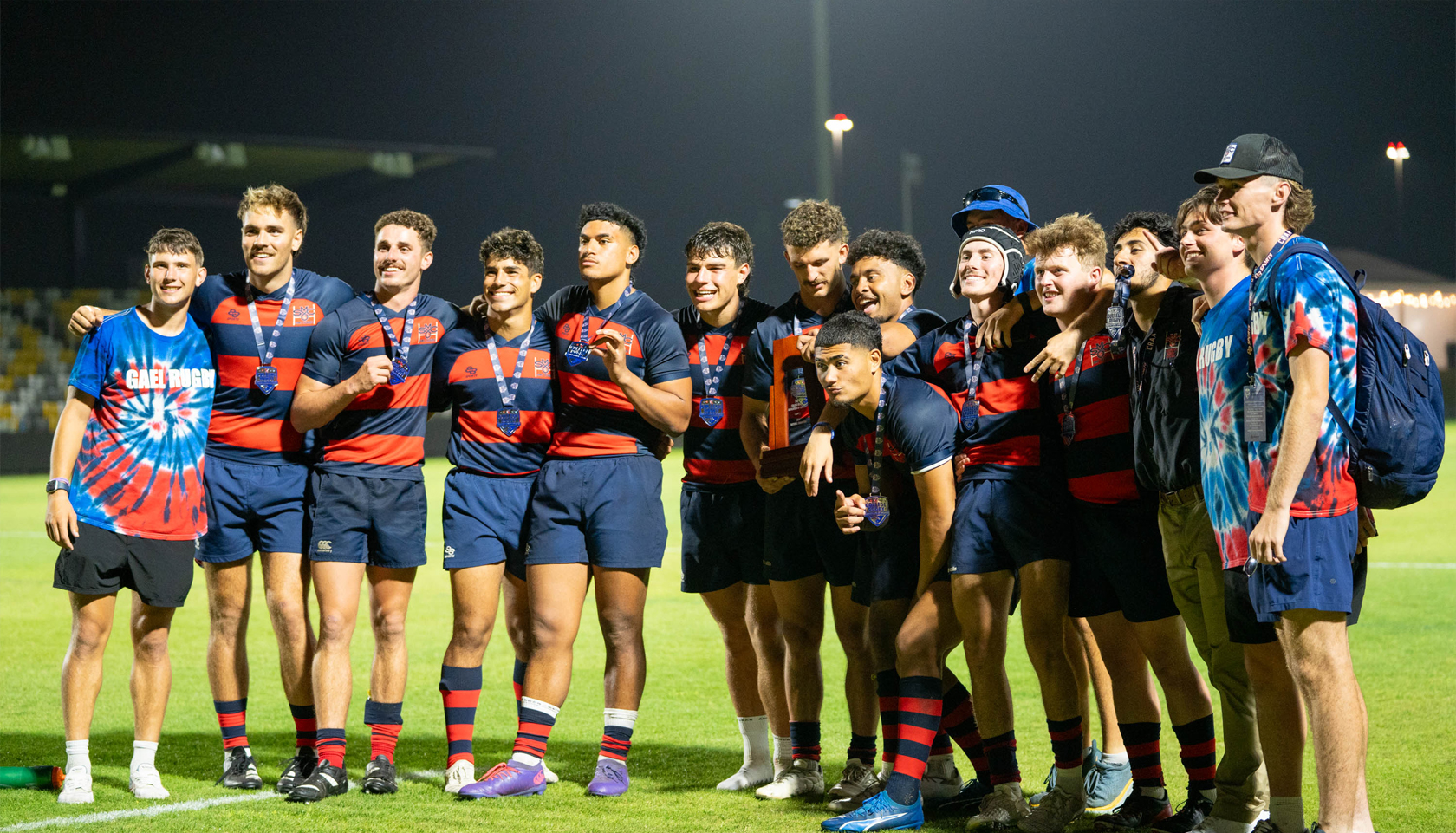
Besting the Bruins: Sialeafuhia Ofa ’28 carries the ball past UCLA defenders in the Gaels’ first-round playoff victory. / Photo by Karen Drinkwater
Three Brothers from Pasifika and the Push by Gaels Men’s Rugby to Defend the National Championship Crown
For Sione Ofa ’27, Sialeafuhia Ofa ’28, and Aisake Tukuafu ’28, the path to Saint Mary’s traces through Salt Lake City and the island nation of Tonga. The path to the playoffs is all about playing as a team 77 strong.
When the Saint Mary’s Men’s Rugby team takes to the pitch in Moraga on Saturday, there will be 15 players on the field. There are about as many more in the reserves, ready to come in when the time calls. Dozens more still have practiced and played hard for months and years to get this Gaels squad into the Elite 8 of the national rugby playoffs, as Saint Mary’s makes a push to defend the crown as national champions. And among that crew of 77, three are brothers whose path to Saint Mary’s traces through Salt Lake City and the island nation of Tonga.
Sione Ofa ’27 is now in his second year of playing as part of Gaels Men’s Rugby. He plays forward and you might see him take to the pitch as part of the Bomb Squad, as he calls it—reserves who come on as the closers, because to win a rugby match the team needs to bring it for the full 80 minutes. You can also call Sione the family pathbreaker: In his footsteps have followed younger brother Sialeafuhia Ofa ’28, who goes by Siale, and older brother Aisake Tukuafu ’28, who also started at Saint Mary’s this year.
Both Siale and Aisake arrived with international experience, playing as part of U18 and U20 teams respectively. And before they arrived in Moraga, all three brothers benefited from veteran rugby player and coach Vea Ofa—who is also their father. Sione and Siale both started playing the game in middle school, when their father founded the Brighton Rugby Club, southeast of Salt Lake City. As they geared up for the second round of playoffs, preparing to host Central Washington on April 12, I sat down to talk with them about the journey so far—and what’s to come.

Beating the Bruins
In the first round of the playoffs on April 5, Siale Ofa was the first to put the Gaels on the board in a 24–17 victory over UCLA. A wing, he received a pass on the outside right, cut back inside, and delivered a stiff-arm to clear the last Bruins defender between him and the try zone. He added another try before the half was through. Credit his nimbleness and speed—his key assets. At 5’10” and around 180, he’s contending with much bigger opponents on the field.
At forward, Sione Ofa has a couple more inches in height—right around 6 foot and 205 pounds. In rugby terms, that’s still not big. “I’m not physically as strong as some of my other teammates,” he acknowledges. “I would say I'm probably more fit and more speedy than some of the forward pack.”
With UCLA, the Gaels knew they were facing a bigger team. But that meant the Bruins wouldn’t be as mobile as the Gaels, Siale says, so that called for working the edges. “Get the ball as wide as possible, to the wingers and hold our width.”
For Sione, who came on later in the match against UCLA, he and the forwards were focused on the scrums: combating the Bruins’ size advantage by jumping quickly and trying to lift earlier. Which goes to another point that Sione makes—about what the team brings to the pitch mentally. In part, mental acuity means deploying the right strategy and tactics. It’s also that sustained energy, he says. And he knows he has a special responsibility to provide that extra boost when, instead of starting, he comes on as a reserve.
“It’s also the brotherhood that you created—especially here at Saint Mary’s. Everything we do, we do as a team.”
—Siale Ofa ’28
“We call it Bomb Squad,” Sione says, “and we always talk about the importance of the fact that when we go on, we’re going to give it our all, because we are the finishers and we need to bring up the vibes. We need to bring up the energy. Our other brothers are already going past 50, 60 minutes, and they’re out of breath, they’re tired. We’re fresh legs. We’re a new start—always trying to be dominant with our energy and do everything that we can to help the next guy who has already been on the field.”
One of the real thrills of rugby, Siale says, is this: “Everyone has a chance. They can run the ball, play defense, play offense, special teams—we can do it all. It’s not just four downs and you’re out. It’s also the brotherhood that you created—especially here at Saint Mary’s. Everything we do, we do as a team.”

The Week Before the Wildcats
The Gaels defeated Central Washington 33–13 in February. Siale Ofa scored two tries in that match—the second when the Gaels were only up by a single point. His brother Aisake pounced on a turnover by Central Washington and scored a try as well, effectively putting the game away. Siale surmises that they’ll face a tough defense with the Wildcats once again. “Probably one of the best defenses in college, just for how connected they are, how well they move,” he says.
Here is how the Gaels prepared for their Elite 8 match hosting the Central Washington Wildcats.
After Saturday’s win over UCLA, they had Monday off. “Tuesday, we had an early micro session at seven within the Rec Center,” Sione says. “We had practice. We had lifts. Wednesday, we had a field mapping—scenarios of what we would do in different circumstances, all that on the field, and what were our three main go to plays off the scrum or lineout, if you’re within the 22 meter line or on the 50.”
When we talk, it’s late Thursday morning. “Today, we just got done with the morning run up to the cross,” Sione says, “and then we’re going to lift and then practice—and go over those basic steps that we need to fulfill for Saturday.”
About that run to the cross: It’s from the turf field up to the hills above campus, then back down—so along with the distance, a couple hundred feet of fairly steep elevation gain. More than that, it’s a destination with symbolic import. “Standing at that cross, that’s where we began in the beginning of the year,” Sione says. “I think to our captains, it was important being there. Nothing is guaranteed—whether we win this week, whether we lose this week, we know that we ended it together at that same starting point. If we do come out with a win next week and the following week, if we do go to national championships, that’s what it means to be a team: Come together as one. You start with each other and you end with each other.”

The Importance of Your ABCs and Field IQ
Saint Mary’s Men’s Rugby fields an A Side, a B Side, and a C Side team. They practice together and they practice hard. “Having the B and C side that we have, we tend to lose to them in practice,” Siale says. “They want it. They're fighting for that spot.”
That’s because, as team co-captain Dominic Besag ’26 makes it clear, no one automatically gets to claim their spot on the A Side. “Especially with all the talent that we have, the young talent, if everyone's fighting for their spot, to be in the playoffs, to go to the natty, I think that just keeps us going.”
“They’re helping us grow, and we need that as a team,” Sione says. “We need every guy from the bottom all the way to the top. For me, personally, that’s what matters the most, because if you don’t have a team behind you and you don’t have that unity, then there’s no team at all.”
Which is not to say that every day goes the way it should. When Siale played his first international match, in high school in a tournament in New Zealand, his team took a drubbing. For the next match, Siale put into play a few of the most recent lessons he’d learned, adjusting to the strengths and weaknesses of his teammates. He scored twice, and the team won 43–5.

One of Siale’s nicknames is Lollipop. But he knows he’s messed up when co-captain Mario Storti ’25 calls him by the English equivalent of his first name, Charlie. And one of the first lessons Siale learned at Saint Mary’s was: “There’s nothing that you can do by yourself. You can never go without the team. Yeah, we have these big names—Dom Besag, Mario Storti, all those guys—but they can’t get to where they want to be without our forwards or the backs. Can’t set up our plays without the forwards. The forwards can’t make the ball unless they’ve got the backs with them.” That’s different from high school when, Siale says, “I would do everything by myself, because it was just easier. Here, they opened up my eyes to realize that it takes the full 15 to make it down the field, and all 77 of us on the team.”
Wrapping up his second season with the Gaels, Sione keys in on both the “intensity and speed” and “the structure, the dynamic,” he says. “It's not just always pass the forwards the ball and they’re gonna carry. We have so many play options available between the backs and forwards that we're able to work together—which, to me, is unique, because you really don't see that a lot within rugby at a collegiate level.”
Siale concurs. “The IQ level at Saint Mary’s is definitely way higher than most of the teams, with the stuff that we do, the awareness that we need to bring. It’s not just, ‘You’re a wing, you stay on your edge and run straight.’ They want us working across the field. They want us doing more things than what we usually do, like throwing lineouts.”
Gaels Head Coach Tim O’Brien tends to eschew the spotlight. But it’s clear he has brought a consistently winning formula to the teams. Last year it led the Gaels to victory over Navy in the national championship—their fourth championship since 2013, and their seventh time to the championship match in that time. Sione credits O’Brien with infusing the sense of dynamism that defines Saint Mary’s play.
“Coach Tim always says, ‘Be comfortable with being uncomfortable, because you’re never just gonna play one position,’” Sione recounts. “‘You have to expect the unexpected. You’re gonna play this position. But you should know every position on the full 15, because who knows—you may be the next man up. You may be a flanker. Now, okay, we probably need you at hook. We probably need you at lock. Who knows—you might go to 13. You might go to 12.’ It’s that optionality and awareness.”
People of the Pacific
Sione and Siale’s parents both emigrated from Tonga to Utah: their mother, Makalita Ofa, in 1972, and their father, Vea Ofa, in 1989; he is a product of Highland Rugby and later played for the USA Tomahawks. In high school, Sione established what he calls a POP club, for People of the Pacific. There wasn’t a POP club when he arrived at Saint Mary’s, though Sione was heartened to see a fair number of students from the Pasifika community here. So this year he started the club. He serves as president, with Siale on the social media crew. They count some 95 students among their members.
On the Thursday in April when we talk, along with preparing for the next round of the playoffs, the brothers have dance practice that evening: The People of the Pacific Club is preparing two dance performances—one for women, one for men—as part of the annual Saint Mary’s Intercultural Center’s Cultural Night Showcase on April 25. It’s an evening of spoken word, theatrical pieces, music, food, dance, and other creative media through which students express their individual and collective identities. This year the theme is “Cultural Constellations,” which seems particularly apt for the POP club. The people of the Kingdom of Tonga, for example, trace ancestry to navigators who used stars, wave swells, winds, and currents to navigate the largest ocean on the planet.
A Game of Respect
Sione is studying Business Administration with a concentration in Entrepreneurship, as is Aisake. Siale is studying Accounting with a minor in Mathematics.
Usually Sione just goes by Sione, since there isn’t anyone else with that name at Saint Mary’s. But sometimes, he says, they call him by the English equivalent of his name: John Love. “Because Sione means John, and our last name means love.”

What comes through in watching him play and talking to him about rugby is certainly a love for the game. But talk to him about traditions or rituals before the games, and he gets reflective. The three brothers, he says, pause to pray. “We always say the Lord's Prayer before we head onto that field, knowing that we have these God-given talents to be where we are now, and that we just feel blessed.”
Siale also confesses that before that, if it’s a home game, he does have one personal ritual: He hits the dining hall for a cup of hot chocolate with a tablespoon of sugar. Then it’s onto the stretches, the team meeting, and the match to come.
And what’s at stake is more than a game, Sione says. “It’s not something that we live and breathe every day, but it’s something to embrace, within the culture that you have as the brotherhood,” he says. “You can’t just say that you’re the best, because I do this and I bring this to the table. No, you have to understand each and every person for their own uniqueness and for who they are, because at the end of the day, you may never know—that could be the person who’s going to be right by your side.”
Siale nods, and offers this: “I don’t think most people realize that it’s a game of respect. It’s not just 30 guys on a pitch trying to kill each other—which it is in the beginning—but toward the end of the game, it comes down to respect. You got to have respect for the game, respect for the players, respect for the ref. Showing that respect will go a long way for you.”
That sense of a long way is also one of the recurring themes for these brothers. “We always try to remember the reason that we got here as a team is thanks to Tim,” Sione says. But he credits everybody back home, he says, “Whether in Tonga or in Salt Lake City…the work that they put in, laid down for us. We’re standing on their shoulders. Everything we do is to represent them, because if we mess up, we all mess up, you know. It’s important to remember your whys—those are your motives, because at the end of the day, that’s what’s going to keep you going. Not every day is going to be a good day, but every day is going to be a blessed day.”
Steven Boyd Saum is Executive Director of Strategic Communications & Content at Saint Mary’s. Write him.








